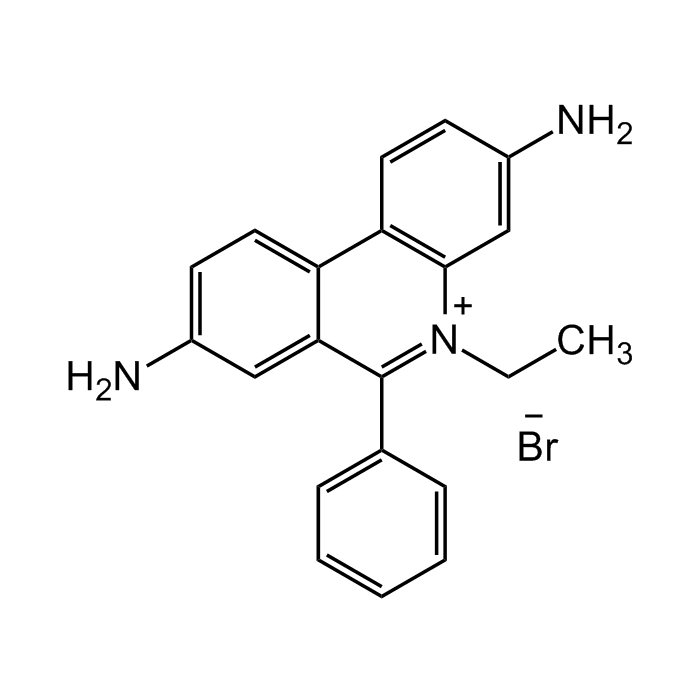Cookie Policy: This site uses cookies to improve your experience. You can find out more about our use of cookies in our Privacy Policy. By continuing to browse this site you agree to our use of cookies.
Chemodex
Ethidium bromide

| Product Details | |
|---|---|
| Synonyms | 3,8-Diamino-5-ethyl-6-phenylphenanthridinium bromide; EtBr; Homidium bromide |
| Product Type | Chemical |
| Properties | |
| Formula |
C21H20BrN3 |
| MW | 394.31 |
| CAS | 1239-45-8 |
| RTECS | SF7950000 |
| Source/Host Chemicals | Synthetic |
| Purity Chemicals | ≥95% (HPLC) |
| Appearance | Dark violet powder. |
| Solubility | Soluble in water (10mg/ml). |
| Identity | Determined by 1H-NMR. |
| Declaration | Manufactured by Chemodex. |
| Other Product Data |
Click here for Original Manufacturer Product Datasheet |
| InChi Key | ZMMJGEGLRURXTF-UHFFFAOYSA-N |
| Smiles | NC(C=C1)=CC2=C1C3=CC=C(N)C=C3C(C4=CC=CC=C4)=[N+]2CC.[Br-] |
| Shipping and Handling | |
| Shipping | AMBIENT |
| Short Term Storage | +20°C |
| Long Term Storage | +4°C |
| Handling Advice | Protect from light and moisture. |
| Use/Stability | Stable for at least 2 years after receipt when stored at +4°C. |
| Documents | |
| Product Specification Sheet | |
| Datasheet |
 Download PDF Download PDF |
Ethidium bromide (EtBr) is the most commonly used nucleic acid stain for PAGE or agarose gel electrophoresis. The fluorescence of EtBr increases 21-fold upon binding to double-stranded RNA and 25-fold on binding double-stranded DNA so that destaining the background is not necessary with a low stain concentration (10 µg/ml). Ethidium bromide has been used in a number of fluorimetric assays for nucleic acids. Ethidium bromide intercalates double-stranded DNA and RNA and acts as a frameshift mutagen. It confers a deep red stain to DNA by acting as an intercalating agent between the starch bases. It has been shown to bind to single-stranded DNA (although not as strongly) and triple-stranded DNA. Because of its ability to bind to DNA, EtBr is an inhibitor of DNA polymerase. It can be used in conjunction with acridine orange to differentiate between viable, apoptotic and necrotic cells. Has been used in the past as an anti-parasitic and anti-microbial agent and described as an uncoupler of oxidative phosphorylation. Has also been used to stain mitochondrial DNA. For staining a gel after electrophoresis, dilute a sample of the stock solution to 0.5μg/ml with water and incubate the gel for 15-30 min. Destaining is usually not needed but can be carried out in water for 15min if decreased background is necessary. The DNA bands can then be detected on a UV light box (254nm wavelength). Ethidium bromide can also be incorporated into the gel and running buffer at 0.5μg/ml and visualized immediately after electrophoresis. Spectral data: λEx=480nm; λEm=620nm (in H2O). λEx=518nm; λEm=605nm (bound to DNA). λEx=530nm; λEm=600nm (in 50mM phosphate buffer pH 7.0; upon binding to DNA).
(1) L.J. Eron & B.R. McAuslan; Biochim. Biophys. Acta 114, 633 (1966) | (2) J.A. Donkersloot, et al.; Appl. Microbiol. 24, 179 (1972) | (3) J.B. Le Pecq; Methods Biochem. Anal. 20, 41 (1971) (Review) | (4) J.C. Stockert; Naturwissenschaften 61, 363 (1974) | (5) M. Miko & B. Chance; FEBS Lett. 54, 347 (1975) | (6) A.R. Morgan, et al.; Nucleic Acids Res. 7, 547 (1979) (Review) | (7) A.R. Morgan, et al.; Nucleic Acids Res. 7, 571 (1979) (Review) | (8) A. Vincent & K. Scherrer; Mol. Biol. Rep. 5, 209 (1979) | (9) W.A. Franklin & J.D. Locker; J. Histochem. Cytochem. 29, 572 (1981) | (10) S. de Jong, et al.; Int. J. Cancer 37, 557 (1986) | (11) D.W. Gray & P.J. Morris; Stain Technol. 62, 373 (1987) | (12) E.A. Ribeiro, et al.; Anal. Biochem. 181, 197 (1989) | (13) P. Borst; IUBMB Life 57; 745 (2005) (Review) | (14) A.M. Villa & S.M. Doglia; Eur. J. Cancer. 45, 2588 (2009) | (15) A.M. Villa, et al.; J. Biomed. Opt. 17, 046001 (2012)





